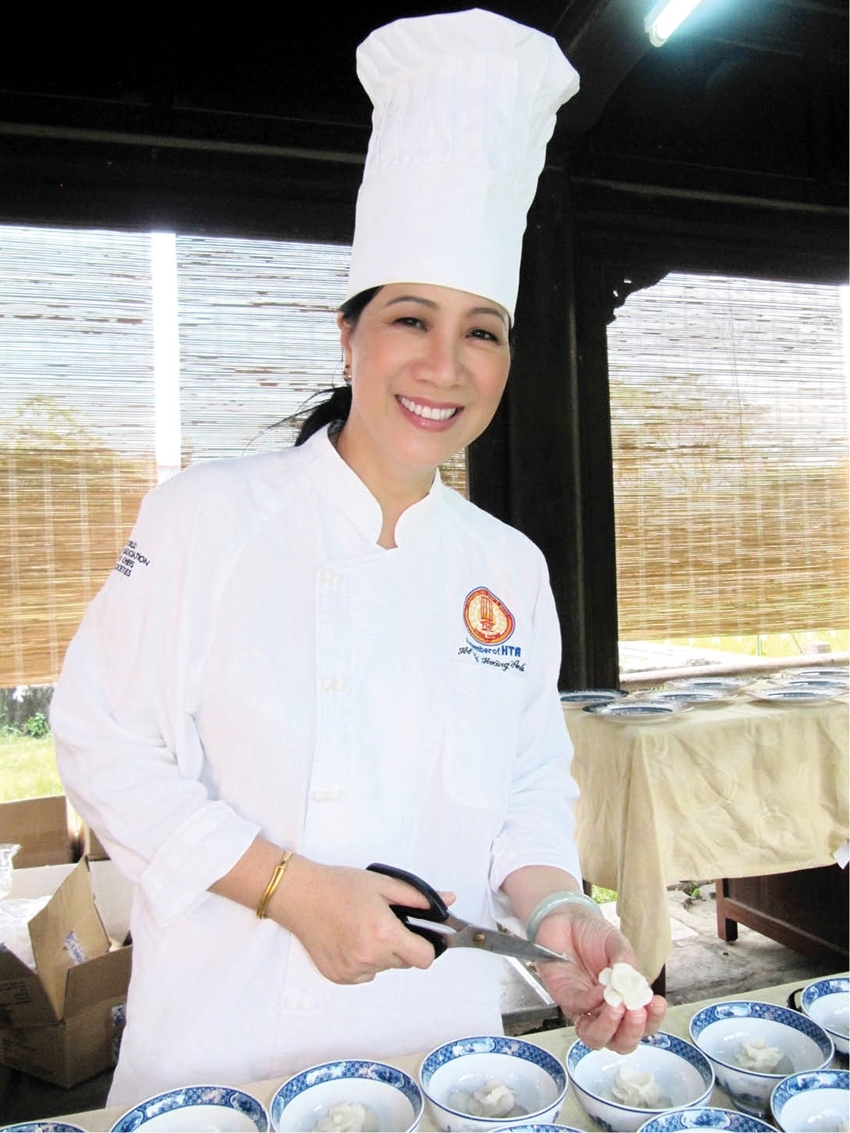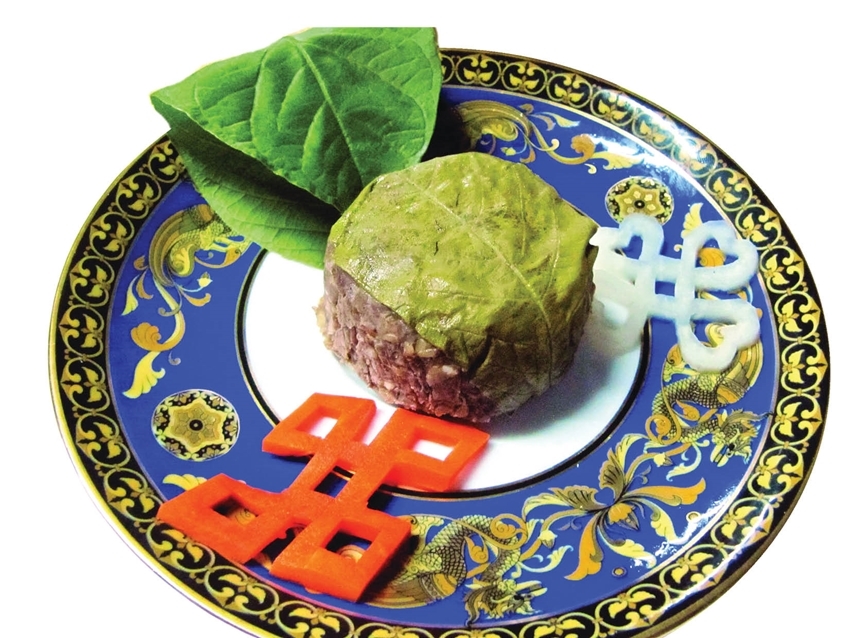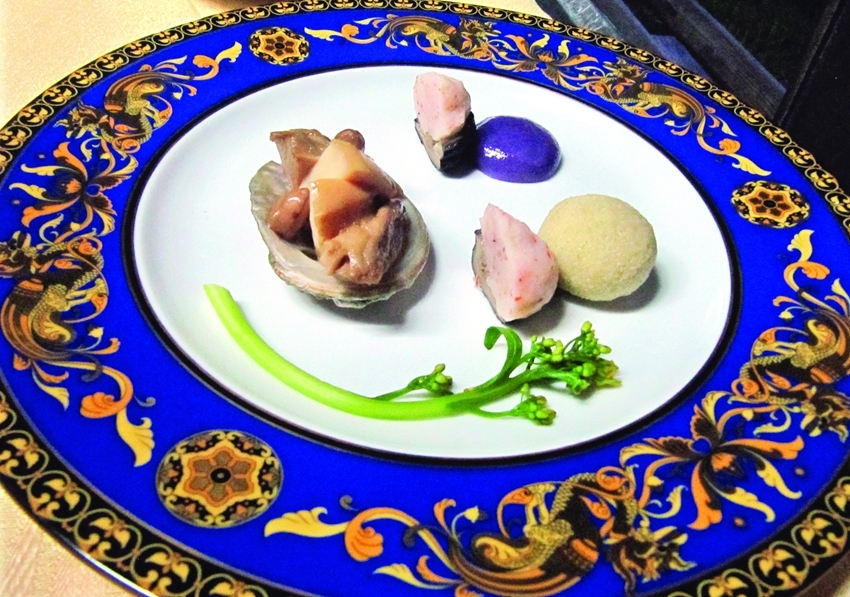 |
| Chef Ho Thi Hoang Anh reviving the royal dishes of the Nguyen dynasty at the Traditional Craft Festival in Hue in 2011 |
It was a bustling day at the beginning of 2011, with Hue eagerly anticipating a new festival to be held in an odd-numbered year. Inquiring with Mr. Phan Canh Viet Cuong, who was then the Head of the Department of Culture and Information of Hue City, about what was new in the festival, Mr. Cuong enthusiastically shared, "A sumptuous banquet for foreign guests under the Nguyen dynasty will be recreated for the first time."
The one entrusted with that "mission" was none other than culinary artist Ho Thi Hoang Anh - the descendant of the last captain of the Thuong Thien team of the Nguyen dynasty. By fate, the female artist traveled from the South to her homeland to recreate a menu for a "sumptuous and delicious" banquet in the royal court.
Until now, I still vividly remember the flavors of the dishes, the magical golden light at Duyet Thi Duong Theater - where the banquet took place - along with the melodies of the Royal Court Music. The service team also wore ancient costumes with black ao dai and turbans. The banquet began with an introduction by researcher Tran Dinh Son, about the history of the Nguyen dynasty's royal banquets and some secrets that were passed down.
 |
| Beef block - one of the royal dishes recreated in 2011 |
Then the "Eight Treasures" menu with sumptuous and delicious dishes (abalone, shark fin, three-striped shrimp, duong fish swim bladder, deer tendon, sea cucumber, lotus bulb, bird's nest...) was served, in the silent space imprinting the charm of Duyet Thi Duong and the melody of the Royal Court Music. The food was elegantly presented with various golden-plated bowls and plates. Guests also used very long bamboo chopsticks for the first time, following the ancient royal dining etiquette.
Speaking of the banquet, artist Ho Thi Hoang Anh called that return a serendipity, to be able to recreate the dishes once practiced at the Thuong Thien Department under the Nguyen dynasty, now only preserved in historical records. The banquet was also an idea full of contemplation from those working in cultural and tourism fields, with the desire to revive royal culinary art based on scientific foundations, historical evidence, and research.
According to artist Hoang Anh, under the Nguyen dynasty, from the time of Gia Long to Tu Duc, the royal feasts were elaborate and included 55 dishes (24 savory dishes, 15 cakes, 10 candied fruits, 3 fruits, rice, sticky rice, sweet soup). From the Dong Khanh period to Bao Dai, due to the dynasty's interaction with France, new dishes were added to the banquet menu to fit the times. At the same time, cooking techniques, serving methods, and presentation also underwent changes. The banquet menu often featured rare and precious ingredients such as peacock meat, rhino skin, bird's nest, abalone, shark fin, sea cucumber, swim bladder, scallops, goose liver...
 |
| The menu "Braised abalone – millet cake, purple sweet potato cake" was elegantly presented |
Some ingredients used for the royal banquet menu, though considered national treasures, are still abundant in nature in Vietnam today. Unfortunately, due to the neglect of royal cuisine, it has gradually become unfamiliar in modern life.
Also, according to artist Ho Thi Hoang Anh, in the past, Phuoc Yen village in Thua Thien Hue specialized in selecting the best ingredients for the Thuong Thien teams responsible for the royal meals. Over the centuries, Phuoc Yen village has produced many generational culinary artists specializing in royal cuisine. After the Nguyen dynasty, they returned to farming. Knowledge and the secrets of the profession gradually disappeared, and now only a small part is preserved in the old families in Hue.
Once the capital of Vietnam, over time, there were about 1,300 dishes prepared in the Hue style, including royal and folk dishes. Regarding the preparation of delicious dishes alone, Mrs. Truong Dang Thi Bich, daughter-in-law of Prince Tung Thien Vuong - Mien Tham, in her work "Thuc Pho Bach Thien," introduced the art of cooking over a hundred dishes in Hue through seven-word, four-line stanza poems.
According to Dr. Tran Duc Anh Son (in an article published on the National History Museum's website), banquets were a ceremonial method that ancient people used for festive occasions or events in a particular era, both to celebrate a festival or an event and to reward the royal favorites or those who had contributed to establishing the feudal dynasty in "pacifying the nation, governing the country."
With that significance, the Nguyen dynasty (1802 - 1945) in Hue held many banquets with rich and specific ceremonies. The book "Kham Dinh Dai Nam Hoi Dien Su Le" compiled by the Internal Affairs of the Nguyen dynasty dedicated two volumes, 97 and 98, to regulations on the organization of banquets in the Nguyen dynasty's court.
Recalling the memories of the grand banquet twelve years ago, as well as reviewing the precious culinary treasure of Hue, we see a vast and valuable heritage for Hue to open unique and outstanding tourism products - an inherent part of the journey to build "Hue - the culinary capital."
